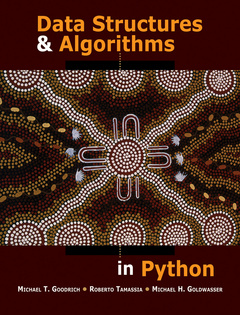Description
Data Structures and Algorithms in Python
Authors: Goodrich Michael T., Tamassia Roberto, Goldwasser Michael H.
Language: English
Keywords
allnew; algorithms; introduction; data structures; python; design; beauty; simplicity; present; advantage; executable source; clear; code; consistent; viewpoint; book; objectoriented; use; inheritance; maximize; types; differences; attention
196.70 €
In Print (Delivery period: 14 days).
Add to cart768 p. · 19.6x24.1 cm · Hardback
Description
/li>Contents
/li>Biography
/li>
Based on the authors' market leading data structures books in Java and C++, this textbook offers a comprehensive, definitive introduction to data structures in Python by respected authors. Data Structures and Algorithms in Python is the first mainstream object-oriented book available for the Python data structures course. Designed to provide a comprehensive introduction to data structures and algorithms, including their design, analysis, and implementation, the text will maintain the same general structure as Data Structures and Algorithms in Java and Data Structures and Algorithms in C++.
Preface v
1 Python Primer 1
1.1 Python Overview 2
1.2 Objects in Python 4
1.3 Expressions, Operators, and Precedence 12
1.4 Control Flow 18
1.5 Functions 23
1.6 Simple Input and Output 30
1.7 Exception Handling 33
1.8 Iterators and Generators 39
1.9 Additional Python Conveniences 42
1.10 Scopes and Namespaces 46
1.11 Modules and the Import Statement 48
1.12 Exercises 51
2 Object-Oriented Programming 56
2.1 Goals, Principles, and Patterns 57
2.2 Software Development 62
2.3 Class Definitions 69
2.4 Inheritance 82
2.5 Namespaces and Object-Orientation 96
2.6 Shallow and Deep Copying101
2.7 Exercises 103
3 Algorithm Analysis 109
3.1 Experimental Studies 111
3.1.1 Moving Beyond Experimental Analysis 113
3.2 The Seven Functions Used in This Book 115
3.3 Asymptotic Analysis 123
3.4 Simple Justification Techniques 137
3.5 Exercises 141
4 Recursion 148
4.1 Illustrative Examples 150
4.2 Analyzing Recursive Algorithms 161
4.3 Recursion Run Amok 165
4.4 Further Examples of Recursion 169
4.5 Designing Recursive Algorithms 177
4.6 Eliminating Tail Recursion 178
4.7 Exercises 180
5 Array-Based Sequences 183
5.1 Python’s Sequence Types 184
5.2 Low-Level Arrays 185
5.3 Dynamic Arrays and Amortization 192
5.4 Efficiency of Python's Sequence Types 202
5.5 Using Array-Based Sequences 210
5.6 Multidimensional Data Sets 219
5.7 Exercises 224
6 Stacks, Queues, and Deques 228
6.1 Stacks 229
6.2 Queues 239
6.3 Double-Ended Queues 247
6.4 Exercises 250
7 Linked Lists 255
7.1 Singly Linked Lists 256
7.2 Circularly Linked Lists 266
7.3 Doubly Linked Lists 270
7.4 The Positional List ADT 277
7.5 Sorting a Positional List 285
7.6 Case Study: Maintaining Access Frequencies 286
7.7 Link-Based vs Array-Based Sequences 292
7.8 Exercises 294
8 Trees 299
8.1 General Trees 300
8.2 Binary Trees 311
8.3 Implementing Trees 317
8.4 Tree Traversal Algorithms 328
8.5 Case Study: An Expression Tree 348
8.6 Exercises 352
9 Priority Queues 362
9.1 The Priority Queue Abstract Data Type 363
9.2 Implementing a Priority Queue 365
9.3 Heaps 370
9.4 Sorting with a Priority Queue 385
9.5 Adaptable Priority Queues 390
9.6 Exercises 395
10 Maps, Hash Tables, and Skip Lists 401
10.1 Maps and Dictionaries 402
10.2 Hash Tables 410
10.3 Sorted Maps 427
10.4 Skip Lists 437
10.5 Sets, Multisets, and Multimaps 446
10.6 Exercises 452
11 Search Trees 459
11.1 Binary Search Trees 460
11.2 Balanced Search Trees 475
11.2.1 Python Framework for Balancing Search Trees 478
11.3 AVL Trees 481
11.4 Splay Trees 490
11.5 (2,4) Trees 502
11.6 Red-Black Trees 512
11.7 Exercises 528
12 Sorting and Selection 536
12.1 Why Study Sorting Algorithms? 537
12.2 Merge-Sort 538
12.3 Quick-Sort 550
12.4 Studying Sorting through an Algorithmic Lens 562
12.5 Comparing Sorting Algorithms567
12.6 Python's Built-In Sorting Functions 569
12.7 Selection 571
12.8 Exercises 574
13 Text Processing 581
13.1 Abundance of Digitized Text 582
13.2 Pattern-Matching Algorithms 584
13.3 Dynamic Programming 594
13.4 Text Compression and the Greedy Method 601
13.5 Tries 604
13.6 Exercises 613
14 Graph Algorithms 619
14.1 Graphs 620
14.2 Data Structures for Graphs627
14.3 Graph Traversals 638
14.4 Transitive Closure 651
14.5 Directed Acyclic Graphs 655
14.6 Shortest Paths 659
14.7 Minimum Spanning Trees 670
14.8 Exercises 686
15 Memory Management and B-Trees 697
15.1 Memory Management 698
15.2 Memory Hierarchies and Caching 705
15.3 External Searching and B-Trees 711
15.4 External-Memory Sorting 715
15.5 Exercises 717
A Character Strings in Python 721
B Useful Mathematical Facts 725
Bibliography 732
Index 737
Michael Goodrich, PhD in Computer Science from Purdue University, 1987; Chancellor's Professor of Computer Science at University of California, Irvine; co-author (with Tamassia) of three other Wiley textbooks and a new computer security text, Addison Wesley, 2011.
Roberto Tamassia, PhD in Electrical and Computer Engineering from the University of Illinois at Urbana-Champaign, 1988; Plastech Professor of Computer Science and Chair of the CS Dept at Brown University; co-author with Goodrich, see texts above.
Michael Goldwasser, PhD in Computer Science from Stanford University, 1997; Associate Professor and Director of CS at St. Louis University; author of Object-Oriented Programming in Python, Pearson, 2008.




